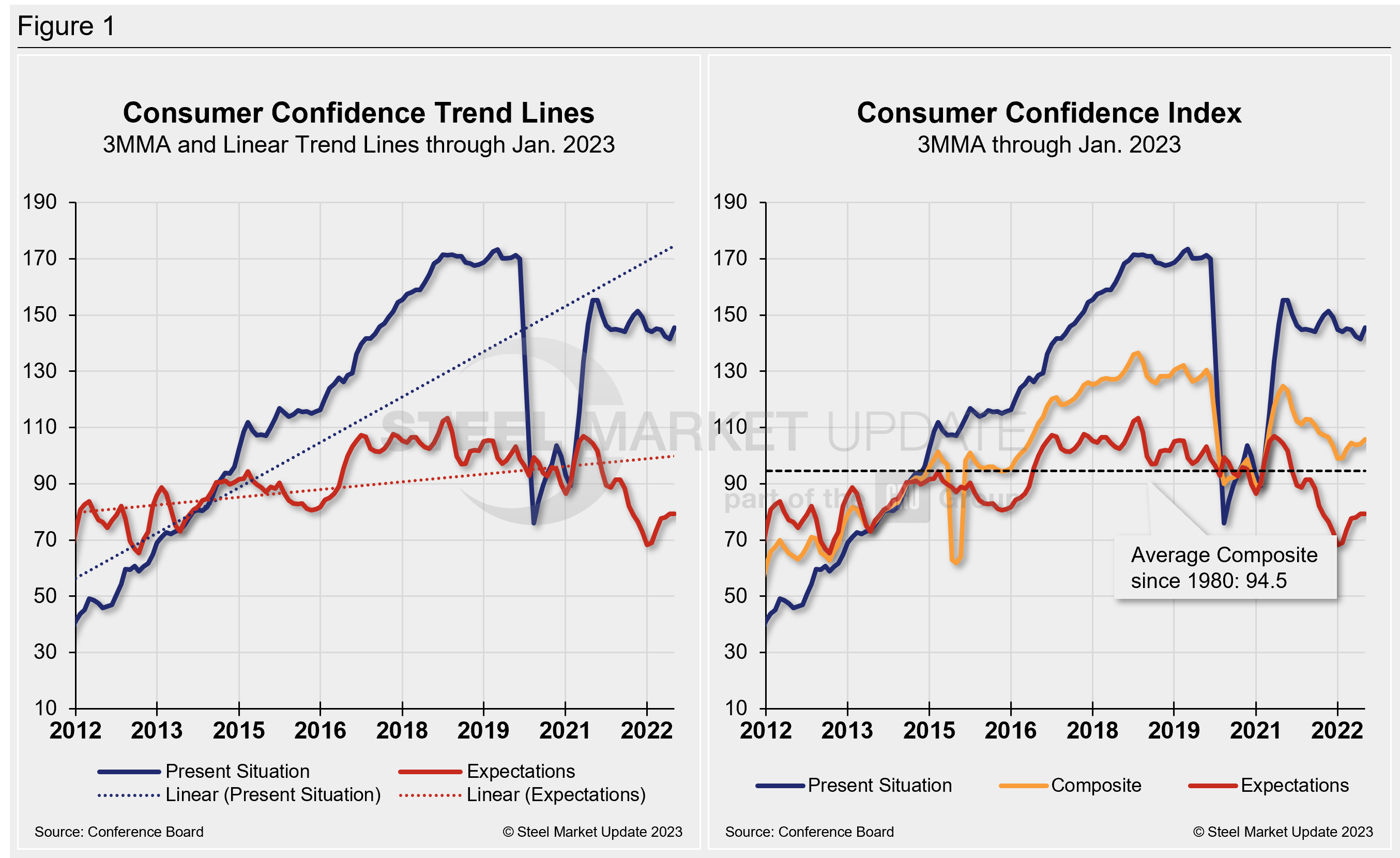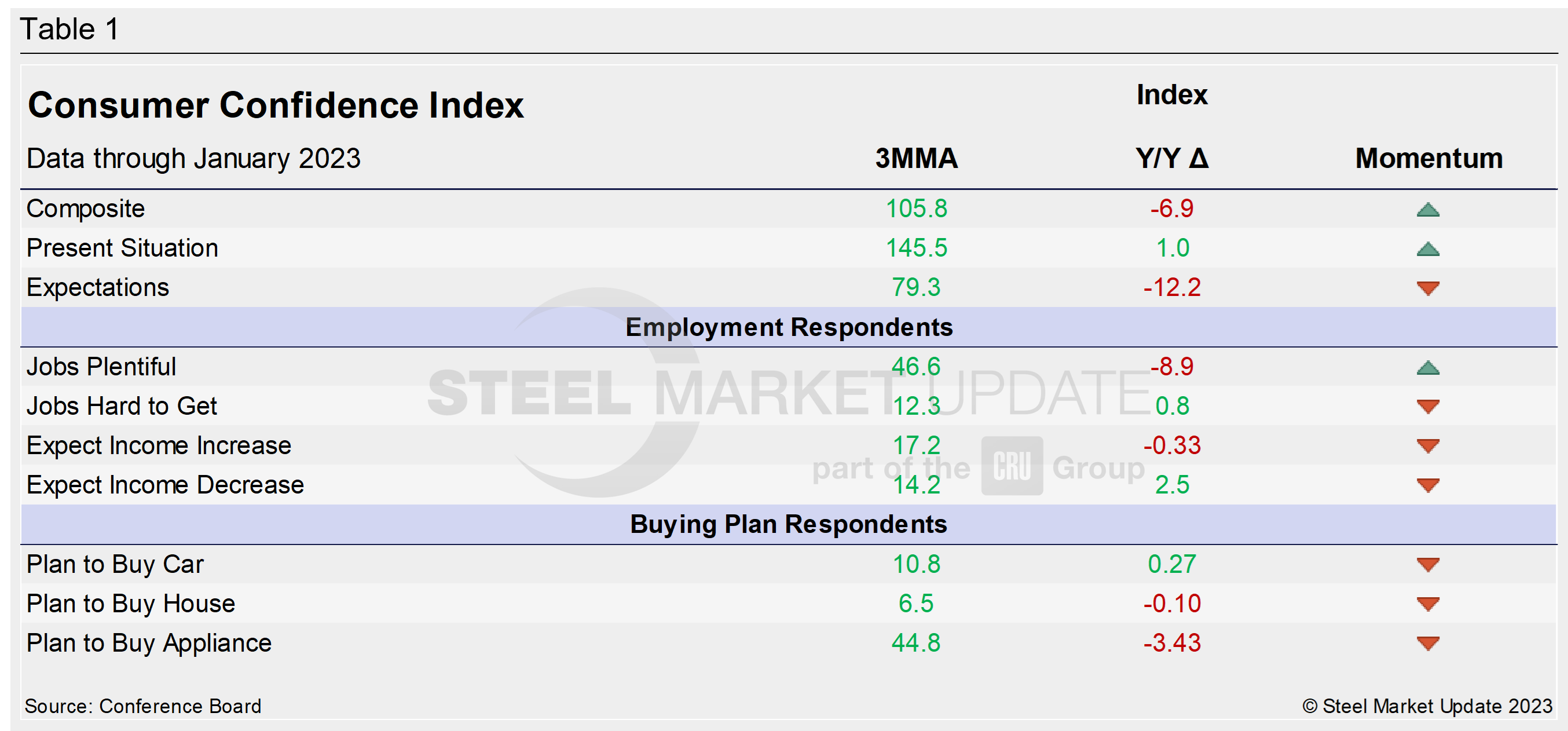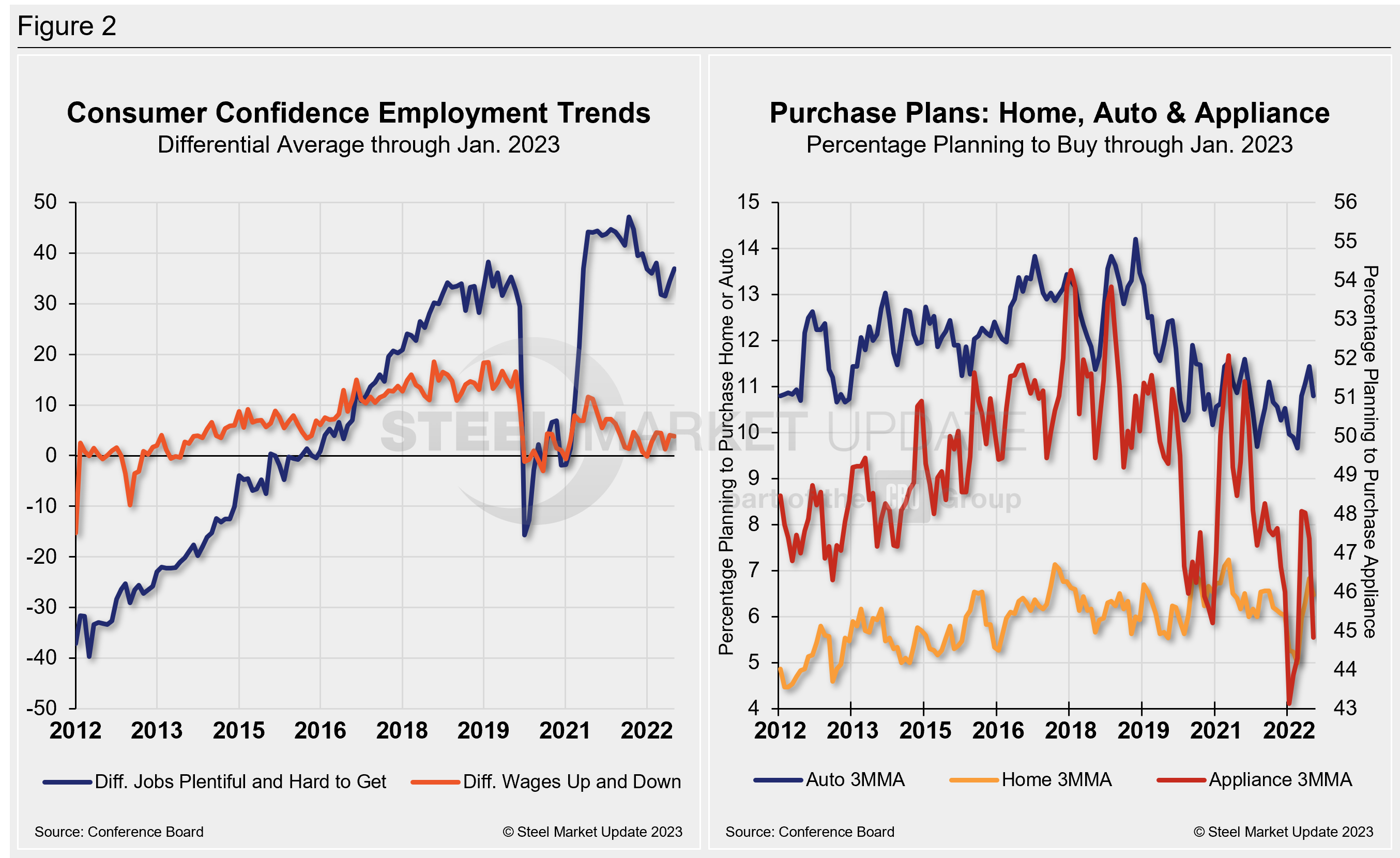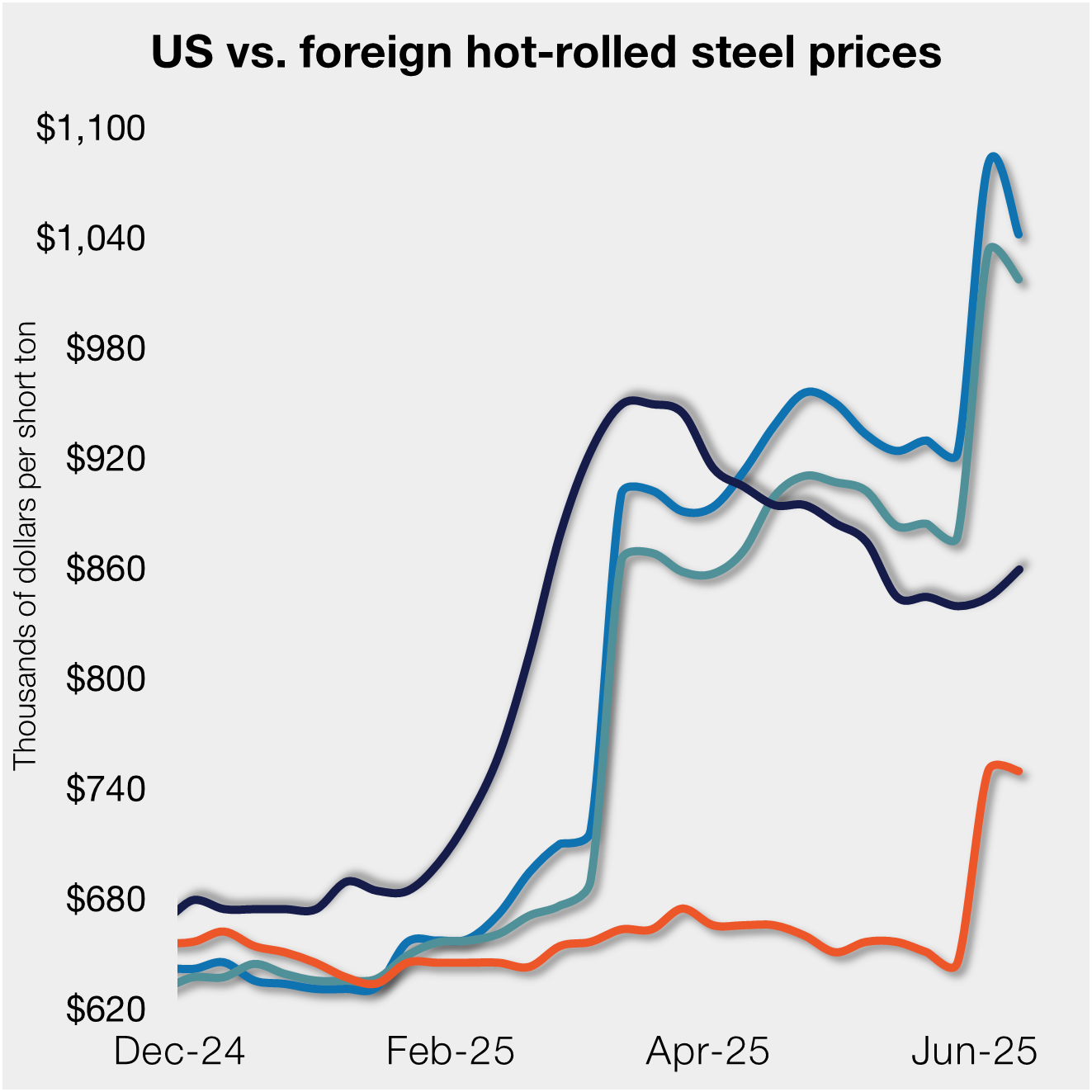International Steel Prices
Consumer Confidence Declined in January
Written by David Schollaert
February 2, 2023
Editor’s note: Steel Market Update is pleased to share this Premium content with Executive members. For information on how to upgrade to a Premium-level subscription, email info@steelmarketupdate.com.
US consumer confidence declined unexpectedly in January after an upwardly revised December measure. The result came as households continued to worry about the economy’s prospects over the next six months, The Conference Board reported.
The headline Consumer Confidence Index slipped 1.9 points to 107.1 in January from 109.0 one month ago, and below consensus estimates the index would be unchanged.
“Consumer confidence declined in January, but it remains above the level seen last July, lowest in 2022,” said Ataman Ozyildirim, The Conference Board’s senior director, economics. “Consumer confidence fell the most for households earning less than $15,000 and for households aged under 35.”
“Consumers’ assessment of present economic and labor market conditions improved at the start of 2023,” Ozyildirim added. “However, the Expectations Index retreated in January, reflecting their concerns about the economy over the next six months.”
The latest survey showed that consumers were less upbeat about the short-term outlook for jobs, and they also expect business conditions to worsen in the near term, Ozyildirim said. “Despite that, consumers expect their incomes to remain relatively stable in the months ahead.”
The Present Situation Index, which measures consumer sentiment toward current business and labor market conditions improved in January, edging higher for the second straight month and reversing the repeated declines seen in October and November. The index rose 3.5 points to 150.9. The Expectations Index, which assesses the short-term outlook for income, business, and labor market conditions, fell to 77.8 from 83.4 the month prior.
Calculated as a three-month moving average (3MMA) to smooth out volatility, The Conference Board’s Composite Index was 105.8, a 1.6-point increase vs. December. Despite rising repeatedly since November, the reading remains well behind a pre-pandemic high of 130.4 set in February 2020.
The Composite Index is made up of two sub-indexes: consumers’ view of the present situation and their expectations for the future. Figure 1 below notes the 3MMA linear trend lines from January 2012 through January 2022 vs. the trend lines of all three subcomponents of the index: Present Situation, Composite, and Future Expectations. All three were above the average composite line prior to the pandemic before falling consecutively through February 2021. The surge from March through June of 2021 pulled all three indexes above the composite line once again. But economic uncertainty continues to weigh on confidence and expectations.

The table below compares January 2023 with January 2022 on a 3MMA basis. The headline index and one of its two sub-indexes have been declining on a year-on-year (YoY) basis. Present Situation has seen a less aggressive fall and is showing a slight gain through January. Expectations show the most volatility over the same period. Only the Present Situation, though, is showing declining momentum through January.
When compared to the same 2020 pre-pandemic period, the Composite Index is down 22.6 points on a 3MMA basis. The Present Situation is down 24.8 points, while the Expectations reading is down 21.3 points this month when compared to the same period in 2019. The Consumer Confidence report includes employment data and purchase plans. These are summarized in the table below.

People found jobs more plentiful in January but were far less optimistic about wage increases compared to the prior month. The differential between those finding jobs and those having difficulty was 36.9 in January, up from 34.5 in December. The measure, though up month on month (MoM), is still trending further away from the most recent high of 44.1 seen just over a year ago. The difference between those expecting wages to rise vs. those expecting wages to fall is 3.8, down 0.1 points MoM, and well removed from the recent high of 11.6 in June 2021.
Buying intentions for big-ticket items — cars, homes, and major appliances — were mostly unchanged in January, though home-buying deteriorated slightly MoM.
“Consumers’ expectations for inflation ticked up slightly from 6.6% to 6.8% over the next 12 months, but inflation expectations are still down from its peak of 7.9% last seen in June,” Ozyildirim said.
The share of consumers planning to buy motor vehicles and appliances such as refrigerators and washing machines were both unchanged MoM at 11 and 44.8, respectively.
These recent dynamics and historical movements are illustrated below in Figure 2.

Note: The Conference Board is a global, independent business membership and research association working in the public interest. The monthly Consumer Confidence Survey®, based on a probability-design random sample, is conducted for The Conference Board by Nielsen. The index is based on 1985 = 100. The composite value of consumer confidence combines the view of the present situation and of expectations for the next six months.
By David Schollaert, david@steelmarketupdate.com

David Schollaert
Read more from David SchollaertLatest in International Steel Prices

Higher US CR prices inch closer to EU, Japanese tags
US cold-rolled (CR) coil prices continued to tick higher this week, while offshore markets were mixed.

Stacked S232 keeps US HR prices below EU
US hot-rolled coil prices crept up again this week but still trail imports from Europe.

Doubled S232 lifts EU, Japanese CR prices over US tags
US cold-rolled (CR) coil prices edged up again this week, and most offshore markets moved in the opposite direction. But the diverging price moves stateside vs. abroad did little to impact pricing trends. The bigger impact was from Section 232, which were doubled to 50% as of June 3. The higher tariffs have resulted in […]

CRU: Sheet demand remains weak, tariff changes again alter markets
Subdued demand has continued to weigh on steel sheet prices globally.

Higher S232 keeps US HR prices at a discount to EU
Domestic hot-rolled (HR) coil prices edged up marginally again this week, while offshore prices ticked down.
